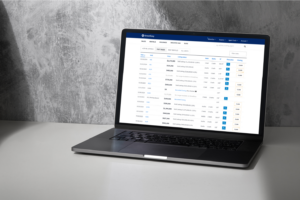“Publish or perish” is a motto among college professors, stressing that, if you want to have a successful career, you have to keep bringing out research. This mantra could just as easily apply to real estate agents in the form of a real estate newsletter. That’s because newsletters are not only another marketing channel for agents, but many have found it to be the foundation of a successful business.
If “successful” sounds good, and “foundation” is what you want, what steps do you need to take to create an effective newsletter?
Decide on an Email Provider
Some brokerages might offer a service for their agents, but if they don’t, there are many email marketing services that are relatively inexpensive and easy to set up. Some of the email services used by NYC agents and brokers are:
(Note: This is not an endorsement of the companies, but just a list of those we’ve seen used by successful agents in NYC).
With just some basic technical know-how — and we are talking very basic — you can get up and running in no time. Each of these email companies offers intuitive setup or there is an account representative to help get you started. Plus, they will give you guidelines on do’s and don’ts around how to build your email send lists and information around the CAN-SPAM Act so that you stay in compliance with the law.
What about the graphic design? The good news is that your firm will probably have a handle on it and will guide you on font, color choices, brand usage, etc. (If anything, some New York City real estate agents say that their firms can be too restrictive in terms of dictating what colors mailings and flyers can be). If not, start collecting newsletters from other agents and notice what graphic designs they use. Simpler designs with strong photos tends to work better.
Set Goals for Your Newsletter
Decide what you want to accomplish with each newsletter you send. Here are some high-level points to think about:
Do you want to….
… establish an expertise in a certain neighborhood or type of housing?
… keep yourself top-of-mind once you meet a potential client?
… showcase your skills as a real estate agent to friends and colleagues?
Your actual goal might be some combination of all three. Just remember, the first step in determining if your newsletter is effectively getting you where you want to go. So focus on what you want out of it, which is ultimately customer contacts and leads.
Example No. 1: Perhaps you just left your previous line of work and are starting a career in real estate. Announce it to your former work contacts. Tell them you are in the real estate business, you’ve joined a brokerage and you would appreciate if they would help spread the word. Perhaps you hope to generate three leads in the course of a year from this newsletter.
Example No. 2: Perhaps you moved from the East Side to the West Side and want to concentrate your real estate business there. Send a newsletter specifically to your contacts on the East Side and and tell them you can help them or their friends with home hunting on the West Side.
Five Ingredients for a Successful Newsletter
And now we come to part of the operation that can handcuff the most verbal real estate agents, which is writing the newsletter. Writing — egads. What do you say? What has meaning? What will resonate with the person who receives it? All good questions. But, if you follow these five ingredients below, you are going down the right track.
1. Topics — Conrad Litz, a Vancouver Real Estate Agent, explained once in an interview with newsletter provider Simon Payn that he tries to continue a conversation that his customers are already having in their heads. So, depending on your market and focus, you might try to answer the question: “Should I rent or buy?” “Is this the top of the market?” “Are interest rates probably going to go up later this year, and what does that mean for me?” Use any of these topics for an upcoming newsletter because if one person is thinking it, there are most certainly others!
2. Tone — If you’re a real estate agent who is a friendly, people person, don’t write in a frozen, formal tone. Conversely, if your strength is in being a tough negotiator, you don’t want your newsletter to be full of exclamation points and smiley faces. Remember, you’re trying to sell yourself — make sure what you’re sending out sounds like you.
3. Call to Action — What your call-to-action might be depends on your goals above. If you want people to realize that you’re at a new firm, you might ask recipients to put your new email in their contact list. If you have a property newly listed for sale, you might want potential buyers to come to your next open house. If you want past customers to send you referrals, ask them to please refer you to their friends or neighbors who are selling. Don’t forget to also emphasize to the newsletter reader what the benefit to them is from fulfilling the call-to-action. In the first example, “Please put me in your address book so that I’m at your fingertips when you have a real estate question — I’m happy to answer” lets the reader know WHY she should put you in her contact list.
4. Effectiveness — MailChimp did a study of the “Best” and “Worst” open rates of emails that they were sending out. Direct headlines like “[COMPANY NAME] Newsletter [DATE] had higher open rates than longer headlines like “[COMPANY NAME] for your next dream home.”
Also, as email marketing provider Constant Contact notes in their “10 Keys to Email Marketing that Works,” don’t forget to get permission from the people on your list. It will be less likely to be marked as spam, more likely to be opened, and it will keep you from running afoul of anti-spam legislation (CAN-Spam). Your newsletter should always include an “unsubscribe” button as well as a way to contact you.
5. Frequency — Some agents do a monthly newsletter. Some, quarterly. Some simply send one announcing a new listing. Sit down and plan out your upcoming mailings and create an “editorial calendar.” Perhaps your April newsletter will be about first-quarter market stats while your May newsletter might be about staging a property. In June, your newsletter might focus on fun things to do in the neighborhood during the summer.
Whatever frequency you pick, just make sure that you’re not sending out a newsletter right before you go on vacation. Rich Gaasenbeek, writing on the ActiveRain.com website, cites the statistic that consumers want a response from their real estate broker within an hour.
While there are many other facets to producing a successful real estate marketing newsletter, the guidelines above should give you a good start in attracting leads.







